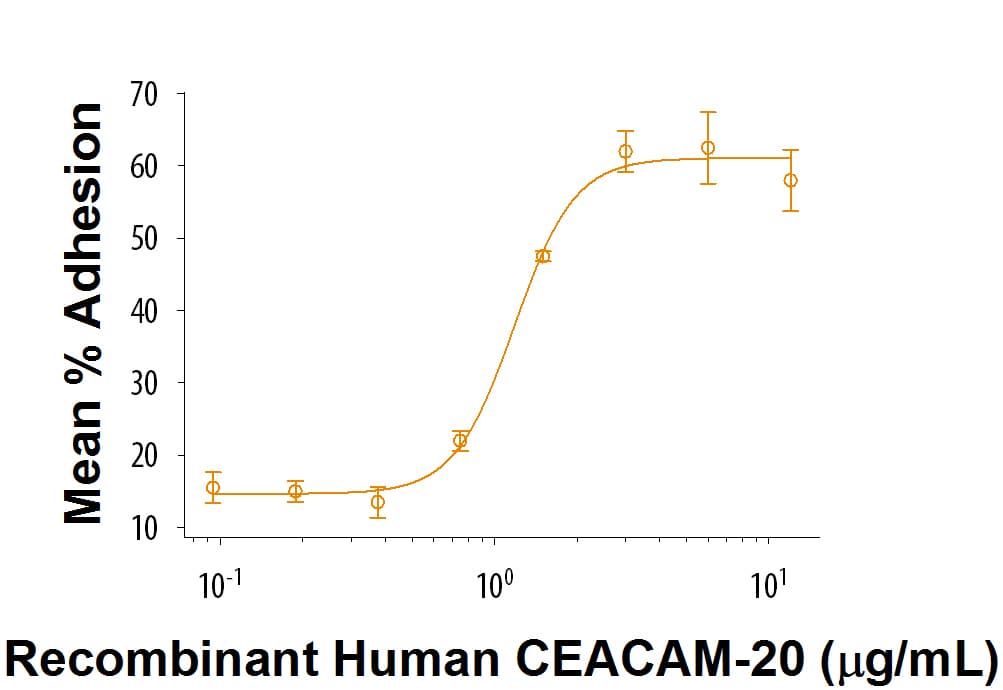 全部商品分类
全部商品分类

 下载产品说明书
下载产品说明书 下载SDS
下载SDS 用小程序,查商品更便捷
用小程序,查商品更便捷


 收藏
收藏
 对比
对比 咨询
咨询Scientific Data
 View Larger
View LargerImmobilized Recombinant Human CEACAM-20 Fc Chimera (Catalog # 9427-CM) enhances L Cells mouse fibroblasts adhesion. The ED50 for this effect is 0.5-2.5 μg/mL.
Carrier Free
CF stands for Carrier Free (CF). We typically add Bovine Serum Albumin (BSA) as a carrier protein to our recombinant proteins. Adding a carrier protein enhances protein stability, increases shelf-life, and allows the recombinant protein to be stored at a more dilute concentration. The carrier free version does not contain BSA.
In general, we advise purchasing the recombinant protein with BSA for use in cell or tissue culture, or as an ELISA standard. In contrast, the carrier free protein is recommended for applications, in which the presence of BSA could interfere.
9427-CM
| Formulation | Lyophilized from a 0.2 μm filtered solution in PBS with Trehalose. |
| Reconstitution | Reconstitute at 250 μg/mL in PBS. |
| Shipping | The product is shipped at ambient temperature. Upon receipt, store it immediately at the temperature recommended below. |
| Stability & Storage: | Use a manual defrost freezer and avoid repeated freeze-thaw cycles.
|
Recombinant Human CEACAM-20 Fc Chimera Protein, CF Summary
Product Specifications
| Human CEACAM-20 (Gln31-Gly450) Accession # Q6UY09 | IEGRMD | Human IgG1 (Pro100-Lys330) |
| N-terminus | C-terminus | |
Analysis

Background: CEACAM-20
Carcinoembryonic antigen-related cell adhesion molecule-20 (CEACAM-20) is a member of the CEACAM subfamily of glycoproteins in the immunoglobulin (Ig) superfamily. Mature human CEACAM-20 consists of a 420 aa extracellular domain, a 21 aa helical transmembrane, and a 114 aa cytoplasmic domain. The extracellular domain possesses four IgC2-like domains, which are stabilized by disulfide bonds, as well as several predicted glycosylation sites (1-5). The extracellular domain of CEACAM-20 is also unique among the CEACAMs because it contains a truncated IgV-like N domain (2). The extracellular domain of human CEACAM-20 has 64% and 62% aa identity to the mouse and rat protein, respectively. Also, the cytoplasmic domain is unusually long compared to most other CEACAMs and is predicted to contain four tyrosine phosphorylation sites, two of which correspond to the immune-receptor tyrosine-based activation motif (ITAM) (2, 3). Human CEACAM proteins have been linked to numerous intercellular-adhesion and intracellular signaling processes including cell adhesion, growth, and recognition, differentiation, angiogenesis, and apoptosis (7, 8). Human CEACAM-20 expression is limited to the reproductive system and the intestinal tract, with the highest levels of expression found in the small intestine and prostate (2, 3). An in vitro model of human prostate morphogenesis showed that CEACAM-20 is co-expressed with CEACAM-1 and plays a critical role in the formation of prostate organoids, making it a marker for prostate cancer (2). Although the exact mechanism is not fully understood, CEACAM-20 may promote the proliferation of intestinal epithelial cells (IECs) (9). There is evidence suggesting CEACAM-20 can induce the production of chemokines like interleukin (IL)-8 and stimulate inflammatory responses in colitis and Crohn's disease (6). CEACAM-20 is also thought be act as a physiological substrate for SAP-1 in the intestinal epithelium (10).
- Tchoupa, A. et al. (2014) J Cell Commun Signal 12:27.
- Zhang, H. et al. (2013) PLoS ONE 8:e53359.
- Zebhauser, R. et al. (2005) Genomics 86:566.
- Beauchemin, N. Arabzadeh, A. (2013) Cancer Metastasis Rev 32(3):643.
- Kuespert, K. et al. (2006) Curr Opin Cell Biol 18:565.
- Murata, Y. et al. (2015) PNAS E4264-4271.
- Obrink, B. (1997) Curr Opin Cell Biol 9:616.
- Horst, AK. Wagener, C. (2004) Handb Exp Pharmacol 283-341.
- Kitamura, Y. et al. (2015) Genes to Cells 20:578.
- Kotani, et al. (2016) Expert Review of Gastroenterology & Hepatology. 10:1313.


参考图片
Immobilized Recombinant Human CEACAM-20 Fc Chimera (Catalog #9427-CM) enhances L Cells mouse fibroblasts adhesion. The ED50 for this effectis 0.5-2.5 μg/mL.




